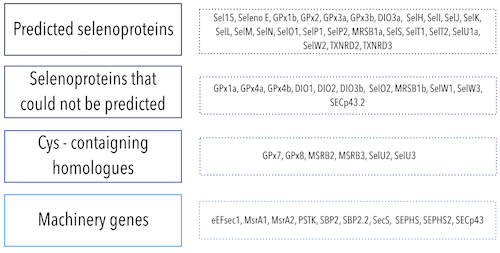Conclusions
As previously reported, selenoproteins are complex proteins involved in many cellular processes. Although some of them have an unknown function, they are conserved among species and they are essential for the proper maintenance of body conditions. One major role that most of them perform is to protect the organism against oxidative stress and reactive oxygen species.
This type of proteins present an extra difficulty which make their analysis harder. Selenocysteine encode for a UGA codon, which is interpreted in most cases as a stop codon by cell machinery. Due to that, some strategies had to be created in order to avoid this signal. In this case, the system created was a secondary structure called SECIs element, present in 3’UTR region after the final exon.
Additionally, this proteins have been suffering different modifications and adaptations along the years and some of them have substituted the characteristic Sec residue for a cysteine. This proteins are known as selenocysteine analogues and they are an important key to detect evolutionary events.
The aim of this study was to determine all selenoproteins and machinery proteins involved in its synthesis in Xiphophorus genome.
Selenoproteins were found by analysing and aligning the studied genome with the one from Zebrafish. This correlation between species was possible as they are closely related in terms of evolution. For this reason, it was more likely to find more similarities between them.
Even Zebrafish is a widespread organism used in many research areas, during this project, some complications could be found due to the lack of a proper protein annotation.
Once species were picked, the analysis of both sequences was done by using some programs (tblastn, exonerate and t-coffee) which gave a predicted protein at the end of the analysis. An output was obtained with these programs, that was interpreted depending on the degree of homology between sequences. Then, to make sure that the results were correctly interpreted, a seblastian analysis was performed. With this program is able to predict the presence of selenoproteins and SECIs elements.
As some results were still not clear enough, an extra analysis had to be done, which consisted in a phylogenetic tree, so it was easier to determine correlation and evolutionary events between proteins.
After the analysis, it can be concluded that 25 selenoproteins, 6 cys analogues and 10 machinery genes can be found in Xiphophorus genome.
Having these results, a good correlation and homology between these species could be seen, although there are particular events like duplications in Zebrafish that were not possible to find in X.cochianus. So, these small differences are the ones that make species being unique.
As it has been explained during the project, this study had some limitations.
First of all, Zebrafish was the organism picked to do the comparison but there are other fishes that are as close phylogenetically as this one. Moreover, in the analysis, Zebrafish proteins were the only ones used, meaning that some proteins could not have been predicted as they were not present in Zebrafish genome.
Secondly, after having all the compiled data and strong evidences that a selenoprotein was found in that region, seblastian analysis could not predict a SECIs elements. Then, some assumptions about the presence or not of that selenoprotein had to be made. This can happen as protein sequences are not perfectly annotated or because this program does not have a 100% fidelity in the predictions.
Finally, fishes are complex organisms as they contain a higher number of selenoproteins and a large number of them are found duplicated, originating new selenoproteins.
So overall, this project has been useful for the understanding of selenoproteins role in the different kingdoms and how variable they can be between species due to evolutionary pressure. Nonetheless, it has also contributed in the scientific society as a new seleno proteome has been characterized.
